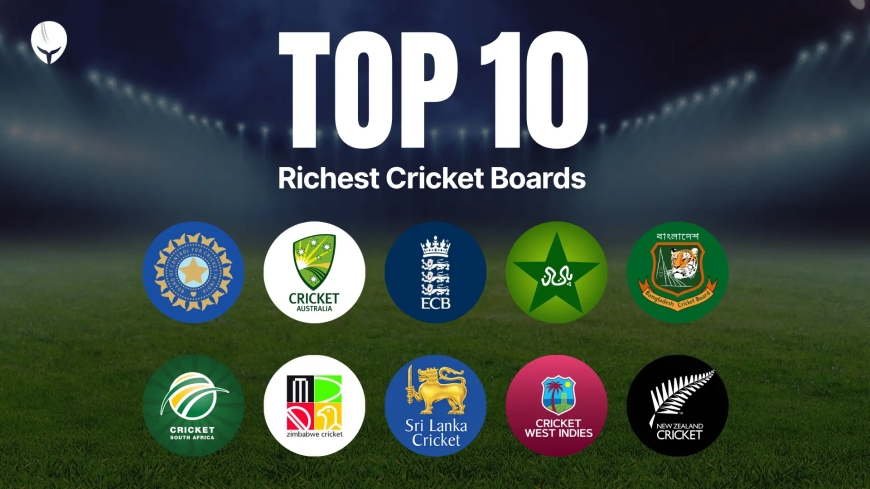The Richest Cricket Boards and What They Own

Cricket is more than just a sportit's a billion-dollar industry with some of the wealthiest sports organizations in the world. The richest cricket boards in the world have managed to build vast financial empires through smart business moves, sponsorship deals, broadcasting rights, and domestic competitions. Understanding what these cricket boards own and how they generate their wealth can give a fascinating insight into the business side of cricket.
In this blog, we will explore the top cricket boards, what makes them so wealthy, and the assets that contribute to their immense financial power. Whether it's their TV rights deals, sponsorships, or stadiums, these boards play a major role in shaping the global cricket scene. Let's take a closer look at the richest cricket boards, including the BCCI, which holds a commanding position in this elite group.
1. The Richest Cricket Boards in the World
Cricket boards from different countries have built up significant wealth over the years. Some have achieved global success through their strong cricketing traditions, while others have capitalized on commercial deals that make them some of the wealthiest sports organizations globally.
1.1 BCCI The Biggest Name in World Cricket
The Board of Control for Cricket in India (BCCI) is undoubtedly the richest cricket board in the world. With an estimated BCCI net worth ofaround $2.8 billion, the BCCI has firmly cemented its position at the top of the cricket financial pyramid. The board generates a huge amount of money through a combination of factors such as broadcasting rights, sponsorships, and the Indian Premier League (IPL), which is one of the most lucrative cricket leagues globally.
What Makes BCCI So Rich?
-
IPL Revenue: The BCCIs primary income source comes from the Indian Premier League. The league generates billions in TV and digital broadcasting rights, which are then shared among the teams, the BCCI, and other stakeholders.
-
Sponsorship Deals: The board attracts big brands like Nike, Paytm, and Vivo, which are willing to pay huge sums for sponsorship and advertising rights.
-
Broadcasting Rights: The BCCI holds some of the most valuable broadcasting deals with television networks and streaming platforms, especially for international series and tournaments.
-
Ticket Sales: India's cricket stadiums like Eden Gardens and Wankhede generate millions from ticket sales during international matches, adding to the BCCI's revenue.
1.2 Cricket Australia (CA)
Next on the list is Cricket Australia (CA), with a net worth of around $500 million. Australia has long been a dominant force in cricket, and its board has made wise decisions to turn the game into a commercial powerhouse.
Why Cricket Australia Is So Wealthy:
-
Big TV Rights: Similar to BCCI, Cricket Australia earns a substantial amount from broadcasting rights, especially for series against major teams like India and England.
-
Sponsorships: Leading companies such as Kookaburra and Commonwealth Bank are top sponsors for CA.
-
The Big Bash League (BBL): Australia's domestic T20 competition has become a fan favorite, attracting massive TV deals and sponsorships, contributing greatly to CAs wealth.
1.3 England and Wales Cricket Board (ECB)
The England and Wales Cricket Board (ECB) stands as another major financial powerhouse. With a net worth of over $300 million, the ECB is not only responsible for Englands national team but also oversees several domestic leagues and partnerships that generate significant revenue.
Key Factors Behind ECBs Wealth:
-
The Hundred: England's newest domestic competition, The Hundred, has proven highly successful in terms of attracting sponsors and viewers.
-
TV Deals and Broadcasting Rights: The ECB also benefits from long-term broadcast contracts with networks like Sky Sports and the BBC.
-
Sponsorships: Major sponsorship deals with brands like NatWest and Puma contribute to the ECBs financial position.
1.4 Pakistan Cricket Board (PCB)
Although it has faced many challenges in recent years, the Pakistan Cricket Board (PCB) remains one of the richest cricket boards globally. Its net worth is estimated at $150 million, with a large portion of its wealth stemming from sponsorship deals and broadcasting rights.
Revenue Sources for PCB:
-
Sponsorship Deals: The PCB has strong ties with brands like Pepsi and HBL, which have fueled the boards finances.
-
Broadcasting Rights: The PCB generates significant revenue through TV broadcasting deals, particularly for international and domestic series.
-
PSL (Pakistan Super League): The PSL has grown in stature since its inception, contributing greatly to the PCB's financial success.
1.5 South Africa Cricket Board (CSA)
The Cricket South Africa (CSA) is another influential cricket board with a net worth of $100 million. South Africa's strong cricketing tradition has helped its board secure solid revenue streams through broadcasting, sponsorships, and hosting major cricket events.
What Contributes to CSAs Wealth?
-
Broadcasting Rights: Like other boards, CSA benefits from lucrative broadcasting deals, especially for series against top cricketing nations.
-
Sponsorships: Major brands such as Standard Bank and Castle Lager are key partners of CSA.
-
T20 Leagues: South Africa's T20 league has started attracting global attention, further boosting CSAs finances.
2. What These Cricket Boards Own
Cricket boards dont just earn money; they own several valuable assets that help boost their financial standing. Here's a breakdown of what some of the richest cricket boards own:
2.1 Cricket Grounds and Stadiums
Owning major cricket stadiums is one of the most profitable investments for cricket boards. Here are some of the notable stadiums owned by the wealthiest cricket boards:
-
BCCI: The board owns the iconic Eden Gardens in Kolkata, the Wankhede Stadium in Mumbai, and the Narendra Modi Stadium in Ahmedabad, which is the largest cricket stadium in the world.
-
CA: Australia owns Melbourne Cricket Ground (MCG), Sydney Cricket Ground (SCG), and Adelaide Oval, which are world-class facilities that generate significant revenue.
-
ECB: The Lords Cricket Ground in London, owned by the ECB, is one of the most famous stadiums in the world, attracting thousands of spectators.
2.2 Domestic Tournaments and Leagues
Tournaments like the IPL, Big Bash League, and Pakistan Super League have become highly profitable assets for the cricket boards that own them. These leagues bring in huge TV deals, sponsorships, and ticket sales.
-
BCCI: The Indian Premier League (IPL) is the BCCIs crown jewel, generating billions every year.
-
CA: The Big Bash League (BBL) is another significant source of income for Cricket Australia, boasting a large TV audience and sponsorships.
-
PCB: The Pakistan Super League (PSL) continues to grow, adding millions in revenue to the PCBs balance sheet.
2.3 Exclusive Broadcasting Rights
Broadcasting rights are among the most lucrative assets for cricket boards. These rights can bring in substantial amounts of money, as networks are willing to pay millions for exclusive content. The richest cricket boards have long-term contracts with top broadcasters like ESPN, Sky Sports, and Star Sports.
-
BCCI: The BCCI's broadcasting rights deals are worth billions, especially for international series and the IPL.
-
ECB and CA: These boards have similar high-value contracts with networks, ensuring they continue to benefit from large revenues.
3. Why These Cricket Boards Are So Successful
What sets the richest cricket boards apart from the rest? Its a combination of factors that have contributed to their success:
-
Commercial Strategies: Top cricket boards have adopted smart commercial strategies that include lucrative sponsorships, strong broadcasting deals, and successful domestic leagues.
-
Fan Base: Boards like BCCI, ECB, and CA have a massive following, which leads to higher revenues from merchandise, ticket sales, and media rights.
-
Smart Investments: These boards have also made wise investments in infrastructure, media, and technology, which have paid off over the years.
4. How Do Cricket Boards Make Money?
Cricket boards generate revenue through multiple streams. The most important ones include:
-
TV Rights: Broadcasting deals are one of the biggest income sources for any cricket board.
-
Sponsorships and Advertisements: Top brands are eager to associate with popular cricket boards, paying huge sums for sponsorship rights.
-
Ticket Sales: International and domestic matches held at major stadiums generate millions in ticket sales.
-
Tournaments and Leagues: Domestic leagues such as the IPL, Big Bash, and PSL contribute massively to the boards income.
FAQs
1. Who is the richest cricket board in the world?
The BCCI (Board of Control for Cricket in India) is the richest cricket board, with an estimated net worth of $2.8 billion.
2. What is the net worth of the BCCI?
The BCCIs net worth is around $2.8 billion, making it the most financially successful cricket board globally.
3. Why is the BCCI so rich?
The BCCIs wealth comes from its IPL revenue, lucrative broadcasting deals, sponsorship contracts, and the massive fan following of cricket in India.
4. Where does the money for cricket boards come from?
Cricket boards generate money through TV broadcasting rights, sponsorships, ticket sales, and domestic leagues like the IPL, Big Bash, and PSL.
5. How do cricket boards spend their money?
Cricket boards spend their earnings on player salaries, hosting international matches, investing in infrastructure, and developing domestic leagues.
Conclusion
The richest cricket boards in the world have not only achieved success on the field but have also mastered the art of managing their finances. From owning iconic cricket grounds and hosting lucrative leagues to securing enormous broadcasting rights deals, these boards have built empires. With the growth of cricket's commercial aspects, it's clear that the financial future of these cricket boards is as strong as their on-field performances.
































